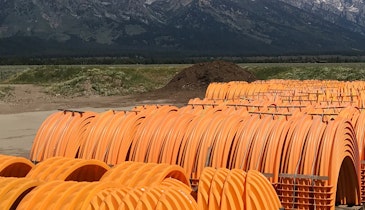It’s amazing sometimes to think of what used to get buried in the name of water and sewer piping (especially sewer) back in the old days as cities grew.
Clay and concrete piping with multiple joints. Wooden pipes. Brick sewers. Orangeburg. It makes you wonder if anyone back then thought about the long-term costs, let alone consequences, of using materials so obviously prone to degradation from all those forces underground: settling, heaving, freezing, thawing, erosion, decay, corrosion, root intrusion.
Now, as the nation’s utilities and municipalities methodically go back over what was done 40, 60, 80, or 100 years ago, there’s an opportunity to do it better the second time — to rehabilitate pipes in ways that make them last longer than the originals. And better yet, do it cost-effectively and with minimal disruption of property.
Many choices
It’s hard to imagine, and impossible to guess, how much money gets wasted each year because of old, deteriorated, offset pipes that let clear water rush into sewer systems. Or how much damage is done when degraded water mains break, or spring slow leaks that generate sinkholes.
Fortunately, modern technology offers numerous effective and long-lasting remedies. Just as car buyers can choose multiple models under the Ford and Chevrolet brands, utility managers can select a variety of options under the general categories of CIPP lining, slip-lining, spray-on lining, pipe bursting, and grouting.
We report on such techniques often in Municipal Sewer & Water, and the current issue contains two more examples of communities doing it the right way — with smart application of conventional trench-and-replace, with advanced trenchless methods, and even with older types of piping installed using better practices.
Thinking long-term
For an example of long-term thinking, consider New Castle County, Del. There, assistant county engineer Dave Hofer and his team look for rehabilitation solutions that will give new or renovated sewer pipe 100 years of service life.
When using CIPP lining, they write stringent specifications and hold contractors accountable for meeting them. But it’s not all about using the latest materials and technologies. In rehabilitating sewer interceptors, New Castle County relies in part on vitrified clay pipe (VCP), used as far back as the days of the Roman Empire.
The problem with VCP, Hofer says, was not with the material itself. The problem was less-than-ideal installation. The county makes sure the VCP interceptors it installs are properly bedded. Gaskets between sections ensure tight and lasting seals. And post-construction laser profile inspections ensure that the work is done to specifications before the county accepts it.
The 100-year service life standard even applies to sealants and mortars used in manhole rehabilitation projects.
Water mains, too
Another trendsetter is the City of Victoria, B.C., which is replacing 20- to 24-inch water mains in one of the biggest trenchless programs of its kind in Canada. As part of the project, the city used a modified slip-lining process with a folded, pulled-in-place HDPE liner system.
The city expects to complete some 90 percent of the three-phase project using trenchless technology. In areas where open-cut replacement was preferable, the city used ductile iron piping and installed a pressure-relief valve station to strengthen the integrity of the overall system.
Communities considering rehabilitation projects with trenchless technology have substantial investigating to do and difficult choices to make. One good place to start is with the Trenchless Assessment Guide for Rehabilitation (TAG-R) from NASSCO.
This software program enables the evaluation of more than 80 technologies for pipeline rehabilitation. It helps consulting and municipal engineers get comprehensive information they can use when choosing a technology for a specific application.
It’s just one more step toward the goal of replacement or rehabilitated infrastructure that’s not just “as good as” but “better than” the original.





